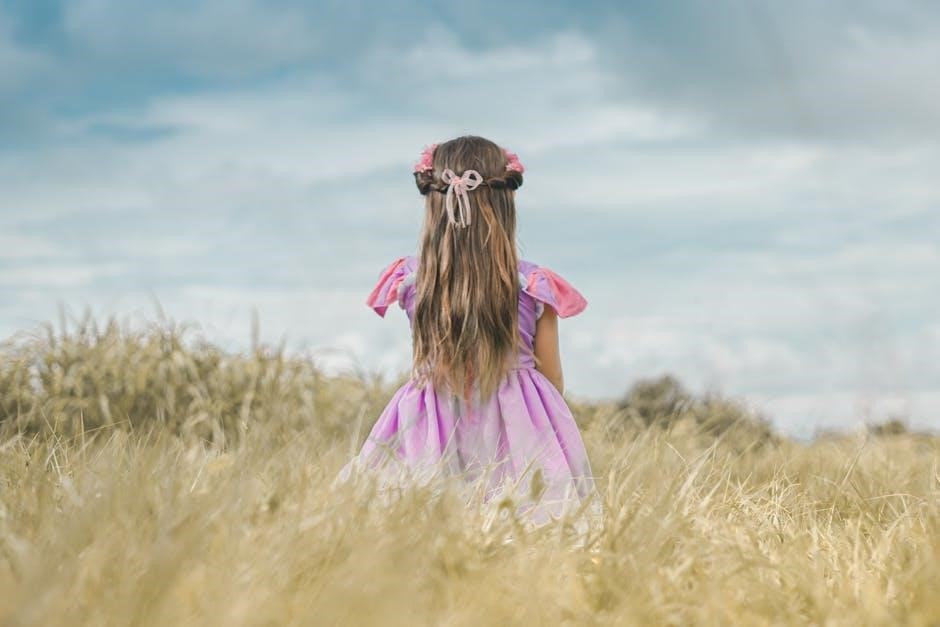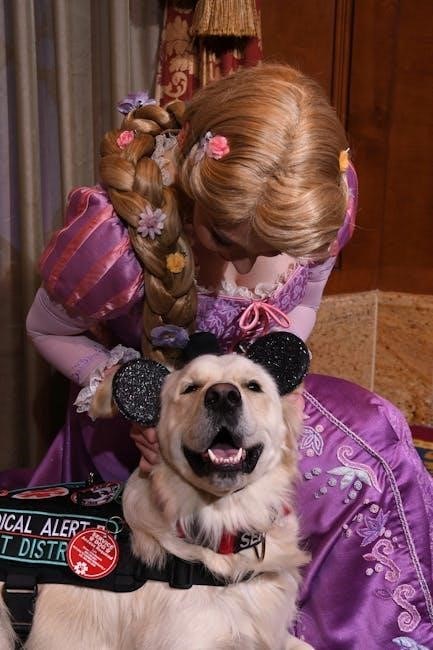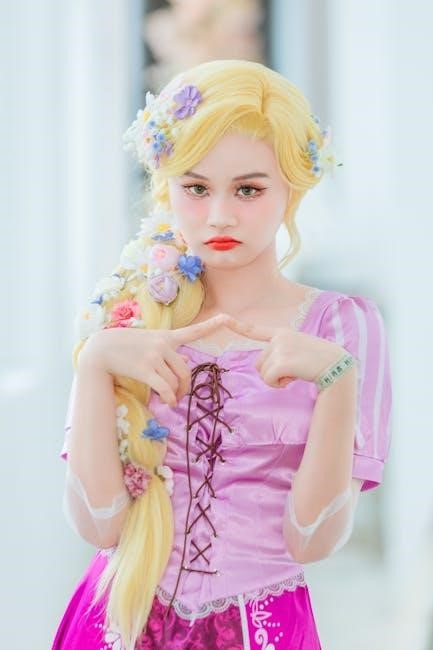Rapunzel PDF: A Comprehensive Guide

Rapunzel‚ the timeless tale of a maiden with extraordinary hair‚ has captivated audiences for generations. This guide explores the story’s enduring appeal through readily available PDF versions. Discover the classic Brothers Grimm version and modern adaptations of Rapunzel’s story.
Rapunzel‚ a beloved fairy tale‚ has enchanted readers and listeners for centuries. Originating from the Brothers Grimm‚ this classic narrative tells the story of a young girl with exceptionally long‚ golden hair‚ confined to a secluded tower by a sorceress. The tale explores themes of isolation‚ longing‚ and the transformative power of love.
The story begins with a couple desperate for a child. The woman craves rapunzel lettuce from a neighboring garden‚ prompting her husband to steal some. This act incurs the wrath of the sorceress‚ Gothel‚ who demands their child as payment. Thus‚ Rapunzel is born and raised in isolation‚ her only companion being the sorceress.
As Rapunzel grows‚ her hair becomes incredibly long. Gothel uses this to her advantage‚ calling to Rapunzel to let down her hair‚ which she then climbs to reach the tower. One day‚ a prince discovers Rapunzel and her secret. This encounter sets in motion a series of events that ultimately lead to Rapunzel’s freedom and a happy ending. The narrative’s enduring appeal lies in its exploration of universal themes.
The Brothers Grimm’s Rapunzel
The Brothers Grimm’s version of Rapunzel‚ first published in 1812‚ stands as the definitive iteration of this classic fairy tale. Their rendition‚ part of their collection of German folk tales‚ solidified Rapunzel’s place in literary history. The Grimm’s tale emphasizes the consequences of choices and the power of true love.
In their version‚ the impetus for Rapunzel’s confinement stems from her father’s theft of rapunzel lettuce. The sorceress‚ Gothel‚ a powerful and enigmatic figure‚ demands Rapunzel as recompense‚ raising her in isolation within a tower. The narrative highlights Rapunzel’s innocence and her longing for connection.
The prince’s arrival marks a turning point‚ introducing themes of romance and escape. Their secret meetings lead to Rapunzel’s pregnancy and‚ ultimately‚ Gothel’s discovery. The tale takes a darker turn as Gothel cuts Rapunzel’s hair and casts her out. The prince‚ blinded by thorns‚ wanders aimlessly until he finds Rapunzel and their children. Her tears restore his sight‚ leading to their reunion and a happy ending. The Grimm’s version offers a potent mix of enchantment‚ adversity‚ and ultimate redemption.
Rapunzel’s Imprisonment in the Tower
Rapunzel’s confinement within the tower is central to the narrative‚ symbolizing isolation and the loss of freedom. Taken from her parents as an infant‚ Rapunzel knows no other life beyond the tower walls. This imposed solitude shapes her character and fuels her yearning for the outside world.
The tower itself is a potent symbol of both protection and imprisonment. While it shields Rapunzel from the dangers of the world‚ it also prevents her from experiencing life and forming meaningful connections. The absence of stairs or a door emphasizes her complete dependence on Gothel‚ the sorceress who acts as both captor and guardian.
Within the tower‚ Rapunzel’s days are marked by routine and limited interaction. Her only companion is Gothel‚ whose motives are shrouded in selfishness and a desire to control Rapunzel’s beauty. The tower becomes a gilded cage‚ offering comfort and security while simultaneously stifling Rapunzel’s spirit. The tower’s isolation serves as a catalyst for Rapunzel’s longing for escape‚ driving her to seek connection with the outside world‚ even if it means defying Gothel’s wishes. This imprisonment underscores the story’s themes of freedom‚ oppression‚ and the importance of self-discovery.
The Witch and Rapunzel’s Hair
The witch‚ often referred to as Gothel‚ is a pivotal figure in Rapunzel’s story‚ driven by vanity and a desire to exploit Rapunzel’s magical hair. Gothel imprisons Rapunzel not out of malice‚ but out of a selfish need to maintain her own youth and beauty. Rapunzel’s hair becomes the source of Gothel’s vitality‚ a tool for her to defy aging and remain youthful.
The magical properties of Rapunzel’s hair are central to the plot‚ serving as the only means of accessing the tower. Gothel commands Rapunzel to let down her hair‚ using it as a rope to climb in and out. This act symbolizes Gothel’s control over Rapunzel and her dependence on the young girl’s beauty.
Rapunzel’s hair is not merely a physical attribute; it represents her life force and the source of Gothel’s power. As Rapunzel grows older‚ her hair becomes increasingly valuable to Gothel‚ intensifying the witch’s determination to keep her locked away.
The eventual cutting of Rapunzel’s hair signifies a turning point in the story‚ marking Rapunzel’s rebellion against Gothel and her reclaiming of her own identity. The loss of the hair’s magic also represents Gothel’s loss of control‚ leading to her downfall and Rapunzel’s eventual freedom.

The Prince’s Arrival and Discovery
The prince’s arrival marks a significant turning point in Rapunzel’s isolated existence. Wandering through the forest‚ he stumbles upon the hidden tower‚ drawn by Rapunzel’s enchanting singing. His curiosity piqued‚ he observes the witch Gothel’s routine‚ witnessing her command “Rapunzel‚ Rapunzel‚ let down your hair.”
Intrigued‚ the prince waits for Gothel to leave and then attempts to replicate her call. To his surprise‚ Rapunzel lets down her long‚ golden hair‚ allowing him to climb up to the tower. This moment symbolizes the beginning of Rapunzel’s connection to the outside world and the potential for liberation.
The prince’s discovery is not merely accidental; it represents the power of fate and the yearning for connection. He is captivated by Rapunzel’s beauty and her voice‚ drawn to her innocence and longing for freedom. Their initial encounter sparks a forbidden romance‚ offering Rapunzel a glimpse of a life beyond the tower walls.
The prince’s visits become a source of hope for Rapunzel‚ a secret escape from her confinement. They plan her escape‚ unaware of the dangers that lie ahead‚ setting the stage for the inevitable confrontation with the witch.
Rapunzel’s Escape and Exile
Rapunzel’s planned escape with the prince takes a tragic turn when their secret is discovered by the witch Gothel. In a fit of rage‚ Gothel cuts off Rapunzel’s long‚ golden hair‚ banishing her to a desolate wilderness. This act symbolizes the severing of Rapunzel’s connection to her past and the loss of her youthful innocence.
The exile marks a period of hardship and isolation for Rapunzel. She wanders through the barren landscape‚ giving birth to twins and struggling to survive. Despite the adversity‚ Rapunzel’s spirit remains unbroken‚ and she nurtures her children with unwavering love.
Rapunzel’s exile is not merely a punishment; it is a test of her resilience and strength. Stripped of her beauty and her comfortable confinement‚ she is forced to confront the harsh realities of the world. Yet‚ it is in this wilderness that she discovers her inner strength and learns to rely on her own resourcefulness.
The exile also serves as a period of purification and growth. Away from the witch’s influence‚ Rapunzel begins to understand the true meaning of freedom and the importance of family. It is in this desolate landscape that she prepares for her eventual reunion with the prince and the restoration of her happiness.
Reunion and Restoration of Sight

After years of wandering blind and desolate‚ the prince‚ guided by Rapunzel’s familiar voice‚ stumbles upon her in the wilderness. Their reunion is a poignant moment of recognition and overwhelming emotion. Rapunzel‚ upon seeing the prince‚ rushes to embrace him‚ her tears of joy flowing freely.
In a miraculous turn of events‚ two of Rapunzel’s tears fall upon the prince’s eyes‚ restoring his sight. This act symbolizes the healing power of love and forgiveness. Rapunzel’s tears‚ born of suffering and longing‚ possess the ability to mend the prince’s physical and emotional wounds.
The restoration of the prince’s sight marks the end of his long journey of despair and the beginning of a new chapter in their lives. With his vision restored‚ he can finally see Rapunzel and their children‚ truly appreciating the family they have created in the midst of hardship.
Their reunion is not just a personal triumph but also a testament to the enduring power of love and hope. Despite the years of separation and suffering‚ their love for each other has remained steadfast‚ ultimately leading them back to one another. Together‚ they emerge from the wilderness‚ ready to face the future with renewed strength and unwavering devotion.
Variations and Interpretations of Rapunzel

The tale of Rapunzel‚ a cornerstone of fairy-tale lore‚ has undergone numerous adaptations and reinterpretations across cultures and artistic mediums. These variations often explore different facets of the story‚ emphasizing themes such as isolation‚ female empowerment‚ and the complexities of motherhood. Some versions may alter the circumstances of Rapunzel’s imprisonment‚ the witch’s motivations‚ or the prince’s role in the narrative.
Interpretations of Rapunzel delve into the psychological and symbolic meanings embedded within the story. The tower‚ for instance‚ can be seen as a representation of confinement‚ both physical and emotional‚ while Rapunzel’s long hair may symbolize her burgeoning sexuality or creative potential. The witch‚ often portrayed as a possessive figure‚ can be interpreted as a metaphor for overbearing parental figures or societal constraints that stifle individual growth.
Furthermore‚ some interpretations examine the themes of agency and self-discovery‚ highlighting Rapunzel’s journey from a passive victim to an active agent in her own liberation. The story’s enduring appeal lies in its ability to resonate with audiences on multiple levels‚ offering a rich tapestry of meanings that continue to evolve with each retelling. By exploring the diverse variations and interpretations of Rapunzel‚ we gain a deeper understanding of the story’s timeless relevance and its capacity to reflect our own hopes‚ fears‚ and aspirations.
Rapunzel PDF Availability and Downloads
Accessing the enchanting tale of Rapunzel in PDF format is remarkably convenient‚ thanks to the widespread availability of digital resources. Numerous online platforms offer free PDF versions of the classic Brothers Grimm story‚ allowing readers of all ages to immerse themselves in the timeless narrative. These platforms often include websites dedicated to fairy tales‚ online libraries‚ and digital archives.
For those seeking visually enhanced experiences‚ illustrated PDF versions are readily available for download. These editions feature captivating artwork that brings the characters and settings of Rapunzel to life‚ enhancing the reading experience for both children and adults.
Furthermore‚ educational websites and literary resources often provide PDF versions of Rapunzel accompanied by study guides and analysis. These resources are invaluable for students and educators seeking to explore the story’s themes‚ symbolism‚ and literary significance. When downloading PDF files‚ it’s essential to ensure that the source is reputable and free from malware or viruses.
By utilizing these readily available resources‚ readers can easily access and enjoy the enduring magic of Rapunzel in a convenient and accessible format. Whether for personal enjoyment‚ educational purposes‚ or simply a nostalgic trip down memory lane‚ the PDF availability of Rapunzel ensures that this beloved fairy tale remains accessible to all.
Modern Adaptations of Rapunzel
Rapunzel’s timeless tale continues to inspire modern storytellers‚ resulting in diverse and imaginative adaptations across various media. Animated films‚ such as Disney’s “Tangled‚” offer vibrant and musical interpretations‚ captivating new generations with Rapunzel’s adventurous spirit and magical hair. These adaptations often reimagine the original story‚ introducing new characters‚ plot twists‚ and themes while retaining the core essence of Rapunzel’s journey.
In literature‚ numerous authors have explored Rapunzel’s story through novels‚ short stories‚ and graphic novels‚ offering unique perspectives on the character and her world. Some adaptations focus on empowering Rapunzel‚ transforming her from a passive damsel into a proactive heroine who takes control of her destiny. Others delve into the psychological aspects of her imprisonment‚ exploring themes of isolation‚ identity‚ and self-discovery.
Stage productions‚ including musicals and plays‚ bring Rapunzel’s story to life with captivating performances‚ elaborate costumes‚ and enchanting sets. These adaptations often incorporate music‚ dance‚ and theatrical elements to enhance the emotional impact of the narrative.
Furthermore‚ Rapunzel’s themes of freedom‚ self-reliance‚ and the power of hope resonate in contemporary society‚ inspiring artists and creators to explore these concepts through their work. Whether through film‚ literature‚ or theater‚ modern adaptations of Rapunzel demonstrate the enduring relevance and adaptability of this classic fairy tale.

